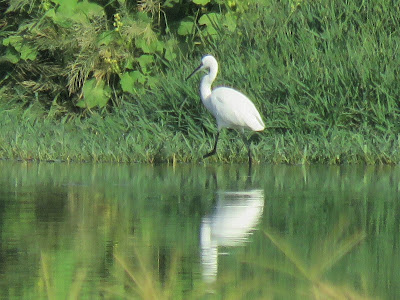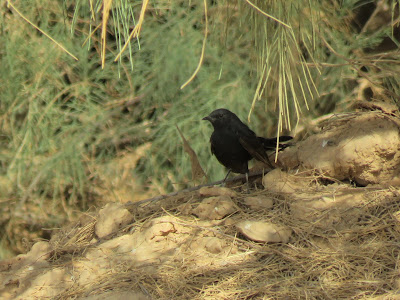I have been away quite a bit this year so reports here are a little sporadic at the moment. I was at Al Hayer on the 3rd but only for a short visit as I had a load of other stuff to attend to that weekend. However I managed to get down for a walk about this weekend (23/9/16).
We arrived on site a little before 6am and immediately noticed a strange phenomena, the sun hovered above the horizon like a giant red ball. The haze over the desert prevented the rays from penetrating so it was easy to stand and marvel. Of course a clever person would have taken a photo or two, but me, well what can I say, I didn't. I often find that, when faced with the marvels of nature all around, I forget the camera. Then when the penny eventually drops its too late. Oh well I am sure you will trust me, it was spectacular.
All that said I did manage to get the odd interesting shot during my walk as detailed below;
It is not that unusual to see one of these gerbils around the place you usually get a fleeting view as they crash down into their burrows. However in this case he actually sat at the entrance to the burrow and allowed me close enough to get a couple of photos. They are generally more active at night when its cooler but as the temperatures have dropped it may be that some daylight outings were added to the routine.
Another creature you normally only get a fleeting view of is the local lizard population. They are active in daytime but rarely move far from cover as they are among the favourite prey of a lot of birds.
Another rare sighting in the area is this lesser flying Homo sapiens. Its the first time this guy has been around here as far as I know but after a short flight over the reeds and lower fields he packed up and left. I wonder if I could use one of those for spotting...... ;)
A distant shot of a small group of Black Crowned Night Herons, this was very early in the morning and they were still roosting I think. In all there were 5 or 6 all in adult plumage.
From distant to close by, this Little Green Bee-eater was resting in a bush. If I had to select a name for todays birding it would have to be Little Green Day because I have not seen as many every before as there were today. I counted 25+ on my walk along the fields. I think this one may be a fairly young bird.
A single Spotted Flycatcher was watching me as I approached the bush he was hiding in. I think he hoped I would not spot him but a few paces further on he thought better of it and flew off.
The Brown Necked Raven was one of a pair I saw today, another migrant, though I have seen very few of these this year.

A bird that qualifies as a local, the White Cheeked Bulbul, they are found all around the Riyadh area and many of the surrounding towns including in the centre of the city where most of the other birds you will see on blogs like this never venture. Strange to think on a few decades ago they did not exist in the country at all.
Back to the migrants again, this is a terrible shot of a Sand Martin but was really the best of a bad lot of photos. There were a very large number of these (100+) feeding over the fields today along with s dozen or so Barn Swallow. They are amazing to watch doing their mid air aerobatics chasing bugs, but a terror to try to photograph.
There were a couple of Masked Shrike squabbling in a tree earlier in the morning but they flew off before I could get a photo. This guy by comparison sat watching me for quite a while before some lorry with no exhaust to speak of roared by and scared off everything.
Another very common bird around the place today was the Common Moorhen. These three were juveniles but there were also a good number of adults. my rough count came to between 25 and 30 birds and doubtless more in the reeds.
In the middle of the field was a single Turkestan Shrike, the only one I spotted today. It perched on a low shrub for some time waiting for prey but flew off out into the field as I approached
The Streaked Weavers were all around the reed beds and now in small flocks, I guess in a week or so they will form into those large flocks we see around at this time of year and then all take off to wherever it is they go to in winter.
Out in the flooded area of the lower field I spotted a couple of Little Egret in the distance and in one of the other pivot fields was a small flock of Cattle Egret. Unfortunately in that field unobserved approaches are all but impossible.
Perched on the sprinkler was one of three White Throated Kingfishers I spotted today, the other ones were very far off. I have almost finished a little piece of research on the distribution of these birds across Saudi Arabia and am getting some very interesting results. More on this anon.
There were also a small number of Namaqua Dove around the place today, this one looks like its molting as did a few others I spotted. Displaying none of that sleek polished look you expect of these guys. In addition to these were good numbers of Rock and Feral Pigeons and Laughing Dove. Oh and I guess I should also mention the Graceful Prinia, which are also always about the place, although I only heard them today.
And a half dozen or so Collared Dove. I was surprised there were not more as ploughed fields usually attract them like a magnet.
There were a couple of Southern Grey Shrike about the place today but I only managed to get this single shot of a young bird in the trees.
There have not been very many Wheatears about this year at all, at least not while I have been looking. This Desert Wheatear was a nice spot for the day.
There were a few Black Scrub Robins around the place today, always a pleasure to see but not that easy to photograph as they feed around the bottom of bushes and trees making getting a focus quite difficult.
Just as I was about the climb into the car this Common Kestrel soared overhead so I managed to get a quick shot. There were three Marsh Harriers around the reed beds today, all female from what I could see. They disappeared for a while when the guy in the parachute was about but made a return later in the day.
An old friend the Crested Lark saw me safely on my way after the days birding, I know some folk get bored of visiting the same place, but this has a special attraction for me as it rarely fails to deliver many exciting finds. I really enjoyed it today and needless to say will be back.
A quick note to birding friends, I don't always manage to get the time to write up a blog after every outing as it can take some time to do, however, I do always load the details of my observations into Ebird. It is important for the long term study of birds that details are recorded and I would urge you guys to detail what you have seen, even if only a few birds, as it would help both with study and possibly conservation efforts also :)
Till next time, happy birding
© Bernard Bracken 2016

































